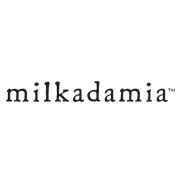This post is written in collaboration with Milkadamia—an Elephant Mindful Partner. They’re dedicated to rebuilding a healthy environment for us all, and we’re deeply honored to work with them. ~ ed.
“The wonderful thing about food is you get three votes a day. Every one of them has the potential to change the world.” ~ Michael Pollan
And One (Amazingly Creamy & Eco) Nut Milk Shall Rule Them All.
If you are anything like me, you might sometimes feel hopeless about climate change and the damage we’re doing to our dear planet. Whelp: here’s a new way to look at the problem.
Many of us know the bad news by now about the fix we’re in.
And it’s clear from the pollution in our seas and skies, the heartbreaking loss of corals at the equator, and disappearing ice at the poles, that the problem threatening life as we know it encompasses the compass.
So, we’re not here to go over all of that ground again.
Instead, we want to focus on the good news: on the gifts this crisis has to offer us…and on a surprising solution that’s right under our feet—because we’re not going to save ourselves by becoming stressed out, nihilistic eco-worriers.
Instead, we want to offer a new way to step up as eco-warriors.
Of course, eco-anxiety is a totally sane response to the times we’re living in—but there is a way to channel that angst into action.
This is our common ground.
There has never been a time when our collective fate is more intertwined than it is now. The global nature of the challenges we face are waking us up to the fact that we all share a common home under a common sky. That our rivers feed into the seas and intermingle, that air and ocean currents intimately interconnect us all. We really do face a common problem.
And our shared increase in eco-anxiety is paralleled by steeply declining faith that any government, agency or wordy diplomatic accord is going to produce the fix. It seems that no-one is stepping up to save us from ourselves, that we are going to have to do that—ourselves, together.
Carbon is not the enemy.
Most of us know that an excess of carbon emissions in the atmosphere is what’s causing the heating of our planet, stopping the earth from cooling itself effectively, and threatening life as we know it.
So, we tend to think of carbon as the enemy, but that’s not the whole picture! In fact, it would be impossible for life on earth to exist as it does without carbon.
Carbon is the building block of life. We are all carbon-based lifeforms—it’s the main component of almost everything in our bodies and other life forms on the planet.
The five “carbon pools.”
Most of the carbon on Planet Earth is stored in five “carbon pools”: soils, oceans, atmosphere, biosphere, and fossils (which is where fossil-fuels comes from). Usually, carbon flows between these pools in an exchange called the carbon cycle, which, since plants appeared on land, has enabled life to evolve and exist in a perfect carbon balance.
But our fossil fuel dependency and the way we manage land and do agriculture is simply pulling too much carbon out of some pools and leaving an excess of it in others, which has a highly destabilizing effect on our environment.
So, in order to save life as we know it, of course we have to stop releasing fossil carbon, but (the other) big question is: where do we put all this excess carbon to get the cycle back into balance?
The solution is right under our feet.
Soil is actually the largest storehouse of carbon on land. In fact, carbon makes up 50% of soil organic matter (SOM), or humus. SOM is vital to healthy soils. But, thanks to modern agricultural methods (tillage, fertilizer and pesticide application, and other practices like clearing forests and overgrazing), 50-70% of the world’s cultivated soils have not only lost their original carbon stock, but are incapable of absorbing carbon back into the soil pool because of the degradation of soil quality.
The solution? Carbon farming: taking the carbon in the atmosphere and putting it back into our soil, through the practice of regenerative agriculture.
You see, unlike carbon in the atmosphere, more carbon in the ground is good for us! It makes healthy, nutrient-rich soil which is full of life and even holds more water. It’s also the most effective actionable response to the carbon excess that’s hothousing our future, and you don’t have to be a farmer to do something about it.
The way we eat can either degenerate or regenerate the planet.
Look for food that’s regeneratively farmed (the more whole foods and less processed foods you buy, the easier it is to find). Ask your local stores to stock products that are regeneratively farmed. Visit your local farmer’s market and asking the sellers there about their farming methods. When buying packaged products, get curious: find out what their brand values are, whether they buy their raw ingredients from regenerative farming sources.
Download the regenerative purchasing guide, here.
Milkadamia: a proud part of the quiet revolution
As more and more individual farmers begin to abandon the agricultural treadmill of ever-increasing fertilizer and chemical inputs and shift attention attention to supporting the health of the soil, Milkadamia is one of the change-making, value-led companies on the front lines of the revolution.
As regenerative farming methods quietly build brand new, bio-abundant, healthy topsoil, these farms perform better and are positively alive from below the ground to the tips of the trees, and the farmers themselves are also regenerated and reenergized—consistently speak of the joy, excitement, relief, sense of accomplishment and especially renewed hope for the future that farming regeneratively engenders
Like these farmers, Milkadamia is in it heart and soil. Not all the macadamia nuts they use in their delicious, raw macadamia nut milk come from their own farm, Jindilli, but the ones that do are grown using regenerative methods.
They’re the first to admit that they’re still learning, but they’re on a quest for the best ways to minimize human intervention and leave the earth to do what she knows best, building healthy new top-soil. They may not be fully there yet but they are fully committed.
This is not idealistic, pie in the sky thinking—this is totally doable.
Just 20% of all the world’s currently cultivated land needs to move to regenerative farming to store enough carbon to halt, then reverse the current build-up of Co2. (Read that again, and let it sink in.) Then, the continuing use of regenerative agriculture practices would mean a reduction of 24-30% of current global annual greenhouse gas emissions. That’s huge…and yet, totally doable.
The industry Milkadamia operates in, plant-based milk, is proof that change on a global scale is within reach.
Mighty dairy, once a virtual monopoly, is being reduced and humbled as consumers across the globe, acting on their environmental, health, and ethical values, redirect their spending away from dairy. This alone demonstrates it is our spending that enables food companies to bloat to seeming invincibility—or not.
We chose who grows what, and who doesn’t, and that is a fantastically encouraging idea. That folk from all over are independently and spontaneously making food and other choices based on their personal values is a heartening and invigorating phenomenon, and our best hope.
We, the world’s consumers are the only power able to enforce the change to regenerative farming on the scale necessary to alter the predicted trajectory of the health of our planet.
We each, inadvertently or not, express our values with every dollar we spend on food. We each will make thousands of food purchases in our lifetime. Every dollar spent on food, not only sustains families, it also sustains industries and agricultural systems.
Turns out, it’s our choice after all.
We are not helpless. We are more informed and more interconnected than ever before. We have seen this in the many grassroots movements that have risen up recently; School Strike for Climate Change and Extinction Rebellion are just a few of the most visible examples. We are not mere pawns in a game played by corporations and governments.
As powerful as they seem, when it comes to food supply and demand, we are the kings and queens, and they serve us. They may have forgotten this—we must not. We may individually be small, but by demanding regeneratively farmed products, we can force change faster than any legislation or protest can achieve.
The environmental issues threatening us are not external to us—they are us. And we are also the fix.
It turns out that it’s more than just a comforting quote: we truly are the change we seek.
We can take responsibility. We can refuse to be passive bystanders. We can up-root destructive agricultural practices. We can restore productivity by supporting regenerative farming. It’s our choice.
Choose regeneratively farmed, deliciously plant-based milk >>
Recommended further viewing and reading:
1. Kiss The Ground
2. The Soil Will Save Us
3. Dirt to Soil
4. Regeneration of Our Lands: A Producer’s Perspective
5. The Soil Story



Read 12 comments and reply